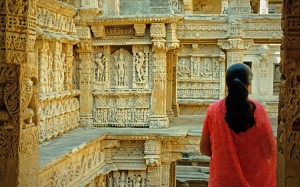India’s Striking Stepwells
Thursday, February 16th, 2017February 16, 2017
For some 2,000 years, sunken water systems called stepwells have provided fresh water and a cooling reprieve for people of the Indian subcontinent. Much of India’s climate is often oppressively hot, and fresh, cool water sources are a necessity. Stepwells are large, open wells constructed in downward tiers that often reach 100 feet (30 meters) below ground level. As their name implies, stepwells are lined with steps, allowing people to descend to the cool air and ground water below. Stepwells provide refreshing water, but they also offer a physical and aesthetic (artistically beautiful) break from the burning light and searing air—and hustle and bustle—of the surface above.

A woman pauses to admire some of the 800 sculptures among the many levels of the Rani-ki-Vav stepwell in Patan, Gujarat, India. Credit: © Shutterstock
India’s best-known stepwells are concentrated in the arid north and west of the country, but they can also also be found in the nation’s steamy southern states. Stepwells were once a common public water source, and thousands of stepwells once lined the subcontinent’s important trade routes. Their numbers have dwindled with the development of more modern water systems, but many are still in use. The elaborate Agrasen-ki-Baoli stepwell sits among the wide streets of New Delhi, India’s capital city. In Ahmedabad in northwestern Gujarat state, the Adalaj-ni-Vav stepwell adds legend to the water: centuries ago, a queen drowned herself there after the city was conquered by invaders.
India’s most famous stepwell, Rani-ki-Vav (queen’s stepwell), sits like an inverted temple in the Gujarat city of Patan. Rani-ki-Vav, built by Queen Udayamati in the late 1000’s, is a World Heritage Site. Such sites are places of unique cultural or natural importance as designated by the United Nations Educational, Scientific and Cultural Organization (UNESCO). The stepwell has seven tapering levels, each lined with intricate sculptural panels detailing—among other things—the incarnations of Vishnu, one of the two main gods of Hinduism. UNESCO calls Rani-ki-Vav “an architectural monument of human creative genius,” illustrating “technological, architectural, and artistic mastery.”
Udayamati built Rani-ki-Vav as a memorial to her husband, King Bhimadeva of the Chalukya dynasty (line of rulers). The stepwell is 210 feet (64 meters) long, 80 feet (24 meters) wide, and 90 feet (27 meters) deep. At the bottom is a 75-foot (23-meter) deep pool of water. In the 1200’s, Rani-ki-Vav was buried in silt deposited by floodwaters of the Saraswati River. The site was lost to history until the 1980’s, when archaeologists excavated the well, which was in an exceptional state of conservation. Over the centuries, however, ground water has shifted, and the pool must now be filled from external water sources. Regardless, Rani-ki-Vav is famous for its artistic splendor, and it still provides a cool break from the heat and sun above.


